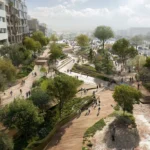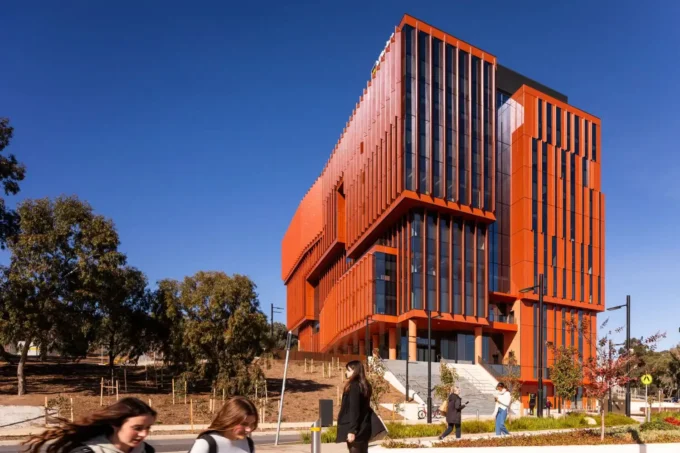The St. Paraskeva Medical Center, designed by AVR Development, represents a careful fusion of historical continuity and modern medical advancement. Located on the grounds of the former Anton and Valeria Bilinsky Hospital, the site offered not only physical foundations for new infrastructure but also an emotional and cultural legacy that shaped the design direction of the new medical facility.
Preserving the ensemble of existing buildings that frame the site, the architects worked within the perimeter of a historic rectangular courtyard to insert a state-of-the-art medical center that responds to contemporary healthcare needs while respecting its surrounding context. The result is a facility that offers not only cutting-edge treatment, but also fosters comfort, orientation, and healing through space and design.

Contextual Strategy: Inserting Modernity Within Memory
The historic hospital complex is organized in a rectangular layout, with buildings surrounding a central courtyard square, which once functioned as a gathering and circulation zone. AVR Development’s strategy did not aim to disrupt this layout but to revitalize and reactivate it.
The new building is inserted seamlessly into the heart of this ensemble, oriented to preserve existing sightlines and create visual and functional continuity across old and new. In doing so, the project transforms a formerly closed courtyard into a dynamic and accessible public-facing medical square—welcoming, legible, and humane.
A Fully Integrated Medical Ecosystem
The new structure consolidates a wide array of healthcare services under one roof. Programmatically, it houses all core departments essential to a modern medical center, arranged in a way that promotes efficiency, patient dignity, and staff effectiveness.
Among the key departments integrated into the new building are:
-
Reception and Outpatient Clinics: Located near the entrance for ease of access, these zones feature clear wayfinding, natural light, and calming interiors to reduce patient anxiety.
-
Temporary Stay Wards: Designed for short-term patients, these rooms prioritize comfort and privacy, with views toward the landscaped courtyard for mental well-being.
-
Operating Block: Aseptic surgical zones include three high-standard operating rooms, a sterile patient preparation area, and post-operative recovery spaces.
-
Intensive Care Unit: Strategically located near surgical and diagnostic areas to ensure rapid response and optimized care.
-
X-ray, Endoscopy, and Diagnostic Labs: Designed with technical efficiency and spatial segregation in mind, to maintain infection control while streamlining workflow.
-
Central Sterilization and Support Facilities: Located in a service core that allows staff circulation without overlapping with public or patient flows.
-
Administrative and Amenity Areas: Offices, staff lounges, and technical support zones are thoughtfully distributed to maintain operational balance.

Architecture as a Tool for Healing
More than just functional, the design employs architectural elements to support healing. Large windows and glazed openings promote natural light and visual connection with the courtyard, creating a sense of openness and orientation that counters the typical institutional feel of medical buildings.
Interior finishes lean toward natural materials and calming tones, which are scientifically shown to reduce patient stress and improve recovery outcomes. Circulation corridors are wide and intuitively organized, minimizing confusion for patients and visitors.
Central Courtyard: A Core of Connection
At the heart of the complex lies the revived courtyard square, now transformed into a therapeutic landscape and gathering space. Not merely decorative, this central square functions as a key node for orientation and decompression, visible from waiting areas, patient wards, and even surgical prep zones.
Benches, trees, and accessible pathways create a gentle rhythm to the space, which doubles as a healing garden, offering staff and patients alike a breath of nature amidst intensive medical operations.

Bridging Heritage and Innovation
Perhaps the most striking achievement of the St. Paraskeva Medical Center is its ability to bridge past and present, crafting an environment where technological sophistication coexists with historical depth. Rather than demolish and replace, AVR Development chose to weave modern health infrastructure into the architectural and emotional fabric of the original hospital site.
This approach not only preserves material memory but elevates it—transforming the former hospital grounds into a new model of compassionate, context-sensitive healthcare design.
Conclusion: A Humanized Approach to Medical Design
In an era where hospitals often prioritize scale and efficiency over atmosphere, the St. Paraskeva Medical Center offers a compelling counterpoint. By balancing advanced medical capabilities with sensitive site integration and thoughtful spatial planning, AVR Development has created a facility that does not simply treat illness—but actively supports healing.
This project is a testament to how healthcare architecture, when executed with empathy and clarity, can restore heritage, support community, and redefine the future of medical care.
Photography: Marina Grynykha
- Adaptive Reuse in Healthcare
- Architecture for Patient Well-Being
- AVR Development Healthcare Architecture
- Compassionate Hospital Planning
- Contemporary Medical Center Design
- Contextual Medical Facility Design
- Courtyard-Based Hospital Design
- Healing Architecture Design
- Heritage Preservation in Hospital Design
- Historic Hospital Redevelopment
- Hospital Interior Design for Comfort
- Human-Centered Hospital Architecture
- Integrated Healthcare Campus
- Modern Medical Campus Architecture
- Natural Light in Healthcare Design
- Restorative Healthcare Environments
- St. Paraskeva Medical Center
- Sustainable Hospital Design Strategies
- Therapeutic Courtyard Design
- Wayfinding in Medical Facilities


































Leave a comment